
The Tetraodontiformes are an order of highly derived ray-finned fish, also called the Plectognathi. Sometimes these are classified as a suborder of the order Perciformes. The Tetraodontiformes are represented by 10 extant families and at least 349 species overall; most are marine and dwell in and around tropical coral reefs, but a few species are found in freshwater streams and estuaries. They have no close relatives, and descend from a line of coral-dwelling species that emerged around 80 million years ago.

Fish anatomy is the study of the form or morphology of fish. It can be contrasted with fish physiology, which is the study of how the component parts of fish function together in the living fish. In practice, fish anatomy and fish physiology complement each other, the former dealing with the structure of a fish, its organs or component parts and how they are put together, such as might be observed on the dissecting table or under the microscope, and the latter dealing with how those components function together in living fish.

Marine hatchetfishes or deep-sea hatchetfishes are small deep-sea mesopelagic ray-finned fish of the stomiiform subfamily Sternoptychinae. They should not be confused with the freshwater hatchetfishes, which are not particularly closely related Teleostei in the characiform family Gasteropelecidae.

The Beryciformes are a poorly-understood order of carnivorous ray-finned fishes consisting of 7 families, 30 genera, and 161 species. They feed on small fish and invertebrates. Beyond this, little is known about the biology of most member species because of their nocturnal habits and deepwater habitats. All beryciform species are marine and most live in tropical to temperate, deepwater environments. Most live on the continental shelf and continental slope, with some species being found as deep as 2,000 m (6,600 ft). Some species move closer to the surface at night, while others live entirely in shallow water and are nocturnal, hiding in rock crevices and caves during the day. Several species are mesopelagic and bathypelagic. Beryciformes' bodies are deep and mildly compressed, typically with large eyes that help them see in darker waters. Colors range from red to yellow and brown to black, and sizes range from 8–61 cm (3.1–24.0 in). Member genera include the alfonsinos, squirrelfishes, flashlight fishes, fangtooth fishes, spinyfins, pineconefishes, redfishes, roughies, and slimeheads. A number of member species are caught commercially, including the alfonsino, the splendid alfonsino, and the orange roughy, the latter being much more economically important. Some species have bioluminescent bacteria contained in pockets of skin or in light organs near the eyes, including the anomalopids and monocentrids.
The Cetomimiformes or whalefishes are an order of small, deep-sea ray-finned fish. Some authorities include the whalefishes as part of the order Stephanoberyciformes, within the superfamily Cetomimoidea. Their sister order, the Beryciformes, includes the flashlight fish and squirrelfish.

Cetomimidae is a family of small, deep-sea cetomimiform fish. They are among the most deep-living fish known, with some species recorded at depths in excess of 3,500 m (11,500 ft). Females are known as flabby whalefishes, Males are known as bignose fishes, while juveniles are known as tapetails and were formerly thought to be in a separate family, dubbed Mirapinnidae. Adults exhibit extreme sexual dimorphism, and the adult males were once thought to be exemplars of still another family, Megalomycteridae.
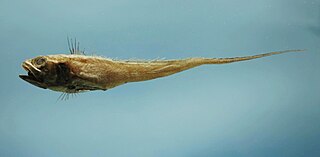
Macrouridae is a family of deep sea fish, a diverse and ecologically important group, which are part of the order of cod-like fish, the Gadiformes. The species in the Macrouridae are characterised by their large heads which normally have a single barbel on the chin, projecting snouts, and slender bodies that taper to whip-like tails, without an obvious caudal fin but what there is of the caudal fin is often confluent with the posterior dorsal and anal fins. There are normally two dorsal fins, the anterior dorsal fin is quite high, the posterior quite low but is longer and takes up a greater proportion of the fish's of the back, species in the subfamily Macrouroidinae have a single dorsal fin. The long anal fin is almost as long as the second dorsal fin is nearly as long as the posterior dorsal, and sometimes it is longer. The pelvic fin is inserted in the vicinity of the thorax and normally has 5-17 fin rays but are absent in Macrouroides. The body is covered in small scales and if they have a photophore, it is usually on the midline of the abdomen just in front of the anus. The bioluminescence of these fish is produced by symbiotic bioluminescent bacteria. The structure of the skull has been used to show their placing in the Gadiformes, but they differ from the typical cods in that they possess one stout spine in the anterior dorsal fin.

The marine hatchetfishes or deep-sea hatchetfishes as well as the related bottlelights, pearlsides and constellationfishes are small deep-sea ray-finned fish of the stomiiform family Sternoptychidae. They are not closely related to and should not be confused with the freshwater hatchetfishes, which are teleosts in the characiform family Gasteropelecidae. The Sternoptychidae have 10 genera and about 70 species altogether.

The Gonostomatidae are a family of mesopelagic marine fish, commonly named bristlemouths, lightfishes, or anglemouths. It is a relatively small family, containing only eight known genera and 32 species. However, bristlemouths make up for their lack of diversity with relative abundance, numbering in the hundreds of trillions to quadrillions. The genus Cyclothone is thought to be one of the most abundant vertebrate genera in the world.
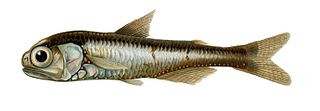
Lanternfish are small mesopelagic fish of the large family Myctophidae. One of two families in the order Myctophiformes, the Myctophidae are represented by 246 species in 33 genera, and are found in oceans worldwide. Lanternfishes are aptly named after their conspicuous use of bioluminescence. Their sister family, the Neoscopelidae, are much fewer in number but superficially very similar; at least one neoscopelid shares the common name "lanternfish": the large-scaled lantern fish, Neoscopelus macrolepidotus.
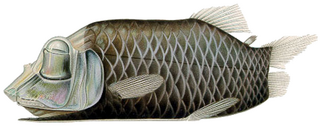
Barreleyes, also known as spook fish, are small deep-sea argentiniform fish comprising the family Opisthoproctidae found in tropical-to-temperate waters of the Atlantic, Pacific, and Indian Oceans.

The Pacific viperfish, Chauliodus macouni, is a predatory deep-sea fish found in the North Pacific. It is reported as being either mesopelagic or bathypelagic, with diel vertical migration to shallower waters. The Pacific viperfish is one of the nine different species that belong to the genus Chauliodus, the viperfish. The Pacific viperfish tend to be the largest of the species, typically reaching lengths of up to 1 foot and are considered an example of deep-sea gigantism. The length-weight relationship of the pacific viperfish varies with sex with females tending to be longer and heavier than males.
This glossary of ichthyology is a list of definitions of terms and concepts used in ichthyology, the study of fishes.
Stomias boa boa, also called the scaly dragonfish or boa dragonfish, is a subspecies of abyssal barbeled dragonfish of the family Stomiidae. It is found at great depths worldwide in tropical to temperate oceans but is absent from the northern Pacific and northwest Atlantic Oceans.
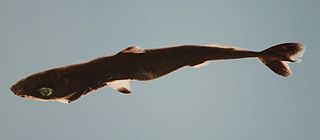
The spined pygmy shark is a species of squaliform shark in the family Dalatiidae found widely in all oceans. Growing no larger than roughly 28 cm (11 in), it is one of the smallest sharks alive, with this record beaten by the dwarf lanternshark. This shark has a slender, cigar-shaped body with a sizable conical snout, a long but low second dorsal fin, and an almost symmetrical caudal fin. Its sister species S. aliae and it are the only sharks with a spine on the first dorsal fin and not the second. Spined pygmy sharks are dark brown to black, with numerous bioluminescent organs called photophores on their ventral surface. The shark is believed to use these photophores to match ambient light conditions, which break up its silhouette and help the shark to avoid being seen by predators below.

The blurred lanternshark is a little-known species of dogfish shark in the family Etmopteridae, found around the world in benthic and pelagic habitats from a depth of 110 m (360 ft) to over 1 km (0.62 mi) down. This shark forms the E. pusillus species group with the smooth lanternshark, which are distinguished from other members of its family by having irregularly arranged, flat-topped dermal denticles that give them a "smooth" appearance. Both species are slender-bodied with long heads, two dorsal fins bearing spines, no anal fins, and light-emitting photophores. The blurred lanternshark is larger, reaching 67 cm (26 in) or more in length. This species feeds on small squid, fishes, and fish eggs, and is ovoviviparous. It has been assessed as of Least Concern by the International Union for Conservation of Nature, because of its wide distribution and lack of threat from fishing pressure.

The dwarf lanternshark is a species of dogfish shark in the family Etmopteridae and is the smallest shark in the world, reaching a maximum known length of 20 cm (8 in). It is known to be present only on the upper continental slopes off Colombia and Venezuela, at a depth of 283–439 m (928–1,440 ft). This species can be identified by its small size at maturity, long flattened head, and pattern of black ventral markings and a mid-dorsal line. Like other members of its genus, it is capable of producing light from a distinctive array of photophores. Reproduction is aplacental viviparous, with females gestating two or three young at a time. The dwarf lanternshark is not significant to commercial fisheries, but could be threatened by mortality from bycatch; the degree of impact from human activities on its population is unknown.

The Neoscopelidae are a small family of deep-sea fish closely related to the lanternfish. They are found in tropical and subtropical marine waters worldwide.
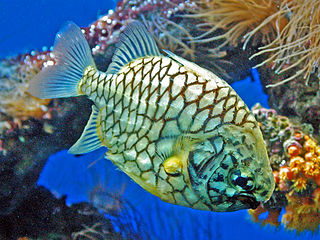
The pineapplefish also known as the Mailfish is a species of fish in the family Monocentridae, and the sole member of its genus. It is also known as the knightfish or the coat-of-mail fish, due to the armor-like scales covering its body, and the port-and-starboard light fish, as it has a pair of bioluminescent organs that are reminiscent of navigation lights on ships. Its specific epithet is from the Latin gloria and maris, meaning "glory of the sea".

Opisthoproctus soleatus is a species of fish in the family Opisthoproctidae. It was first described in 1888 by Léon Vaillant. The species lives in most tropical seas, but is more common in the eastern Atlantic, from western Ireland to Mauritania and from Sierra Leone to Angola, and also in the South China Sea. O. soleatus can grow to a standard length of 10.5 centimetres (4.1 in) and usually live from about 500 to 700 metres deep.

















